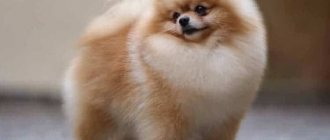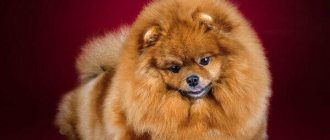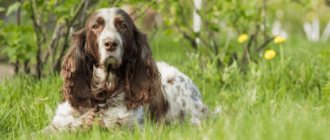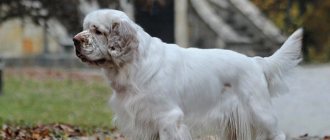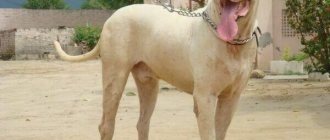Spaniels are a large group of breeds that include mainly hunting dogs.
It includes breeds such as Cocker Spaniel, Russian Spaniel, Irish Water Spaniel, Field Spaniel, Clumber Spaniel, Cavalier King Charles Spaniel, Welsh Springer Spaniel and others.
But this group includes not only working dogs, but also decorative ones, including dwarf breeds.
The Continental Toy Spaniel or Papillon is a breed of decorative dog, distinguished by rather large ears and a very pretty appearance.
The attractive exterior, combined with developed intelligence, devotion and cheerfulness, has made the representatives of this breed popular among dog breeders around the world.
Origin story and what it looks like in the photo
Continental Toy Spaniels are a French breed of dog, as indicated by its second name “Papillon”, which is translated from French as “butterfly”.
According to dog experts, the closest relatives of these dogs are dwarf spaniels, which is why they are called continental toy spaniels.
It is not known exactly when this breed was bred, but dogs similar in appearance to its representatives were depicted in paintings by famous artists, including Titian, about 800-1000 years ago.
In addition, these animals were depicted in portraits of nobles and royalty, suggesting that they were popular among the upper classes.
Thus, it is known that Papillons were the favorite pets of Marie Antoinette, Henry II, Louis XIV, and the Marquise de Pompadour.
The Great French Revolution significantly influenced the population of these dogs: spaniels, considered a symbol of the bourgeoisie, were massacred, which led to the almost complete disappearance of Papillons.
The breed was revived only in the 18th-19th centuries.
Despite the fact that representatives of this breed were very popular among European monarchs, they came to England only in 1905. After quite a long time, these animals, which previously served as court toys, became a working breed, which was successfully used for herding sheep.
In the 20s XX century dog breeders and cynologists crossed Papillons with Spitz dogs, which improved the coat of spaniels, making it silkier .
The first breed standard was approved in 1934.
Interesting Facts
Dwarf Papillons are unique dogs with a rich history shrouded in mystery. Owners are learning more and more about their pets:
- Two types are included in one standard: Papillon and Phalene. These dog breeds are completely identical, except for one detail - ears. The name "phalen" translates as "waterfall". The auricles of dwarf phalenids are set low, and the ears themselves droop and lie close to the temples so that the fur fringes form an imitation of a waterfall.
- Despite their small size, continental dwarf spaniels are not decorative dogs. They have protective and hunting instincts, and their level of intelligence is considered one of the highest among dogs (an honorable 8th place in terms of intelligence development).
- The richest toy spaniel inherited $10,000. The one named Sophie was the favorite of actress Lauren Bacall.
Description and standard
Continental Toy Spaniels are dogs with a harmonious build and strong bones. Their light and free movements convey elegance and grace.
Breed standard:
- the head is small, the skull is rounded, a furrow is barely noticeable between the eyes;
- the bridge of the nose is straight, the lobe is black, round, slightly flattened on top;
- the transition from the forehead to the pointed muzzle, slightly shorter than the skull, is well defined;
- the lips are thin, fit tightly to the jaws, and are pigmented black;
- strong jaws, scissor bite;
- the eyes are large, but not protruding, almond-shaped, low-set, the iris is dark;
- the neck is dry, set high, slightly curved at the back of the head;
- the body is strong and straight, the loin is strong and slightly arched;
- The chest is wide, deep, slightly flat on the sides, ribs are curved;
- the stomach is moderately tucked;
- the tail is set high, the fur covering it forms a fountain;
- limbs straight, short, strong;
- claws are black, white pigmentation is acceptable in males with white coat;
- there is no undercoat, the guard hairs are thick, wavy and silky, the hair on the head, muzzle, on the outer side of the front legs and on the lower part of the hind legs is short, on the body it is of medium length, there is a beautiful collar on the neck.
The ears of representatives of this breed are large, firmly set, slightly shifted back and distant from each other.
Depending on the position of the ears, the breed is divided into 2 types:
- Phalene - dogs with hanging, high-set ears, the hanging part is long, mobile, covered with long hair;
- Papillon - spaniels with erect, high-set ears, the inner edge of well-open shells forms an angle of about 45°.
To preserve the purity of a particular species, it is forbidden to cross both varieties.
English springer
The breed can be called the progenitor of all living Spaniels - the most ancient companion and hunter of the English nobility is the Springer. A large dog, reaches 46-56 cm at the withers and weighs up to 30 kg. Stately, muscular, strong, but graceful in movement, light and fast. Dogs were especially popular during the Renaissance: great artists painted them on canvas and described them in novels.
A good family pet: kind, loyal, active, devoted. The best friend for children, a partner for running and playing. Suitable for active people with free time for walking and hunting.
Springers cannot be left alone for a long time: they begin to whine, bark, and destroy everything around them. Recently, there has been a tendency towards increased incidence of rage syndrome. This is a neurological disease related to epilepsy. At the moment of an attack, the dog does not distinguish between commands and does not understand where it is, and attacks its owners for no reason.
Character traits
Papillons are real royal dogs, combining not only elegance, grace and beauty, but also intelligence, a cheerful and cheerful disposition and good nature.
These dogs grow up to be loyal friends and wonderful companions. They are very devoted to their owner, understand him perfectly and are always ready to fulfill his every wish.
They need communication and strive to be the center of attention..
They do not like to be left alone, this can lead to destructive behavior. But, if there are other pets in the house with whom Papillons can communicate, they can endure time without their owner more easily.
Despite their compact size, representatives of this breed are good watchmen and security guards, since they are quite wary of strangers, closely monitor them and, if they feel that their owner is in danger, they will boldly come to his defense.
Continental Toy Spaniels are well suited for apartment living and adapt to life outside the city without problems . They are active and restless and need regular walks and active games.
Representatives of this breed are smart and quick-witted, they are not characterized by stubbornness and the desire to dominate.
They are easy to train and educate, because they not only quickly remember commands, but also strive to please the owner and please him.
Expert opinion
Kozhevin Semyon Kirillovich
Expert dog handler.
Continental Toy Spaniels are incredibly intelligent, as evidenced by a study that tested 79 dog breeds and Papillons came in 8th. The undoubted advantage of this breed is its balanced psyche and lack of tendency to mood swings. It should be remembered that these dogs are quite jealous and can be seriously offended by the owner if they feel that he is paying attention to someone else.
Papillon: owner reviews
Papillon
An unusual little dog, brought to us from France, whose ears look like butterfly wings, is gaining more and more popularity. A feature of this breed is irritability associated with lack of attention, so the kids are very sociable and playful. Despite its small size, the dog is quite hardy and happily keeps company on trips, calmly enduring the road. The animal is distinguished by long hair and a beautiful multi-colored color.
Here's what other owners of dogs of this breed write - reviews of the Papillon:
- Maria, 26 years old Throughout my entire life, as far as I remember, we only kept cats at home. But one day I consulted with my mother, and we decided to get a dog. We thought about it for a long time, and eventually decided on the Papillon. And what I want to say is that this wonderful creature has become like a real family member for us. Our Atom is a smart, energetic, cheerful and flexible dog. He really likes it when we spend a long time on walks, and we always go to bed together.
- Edward, 19 years old Papillon is a wonderful breed of dog. Suitable for those who want to have a devoted and active friend with good health. I'm just shocked how attentive my Snowball is. When I tell him something, he looks straight into my eyes as if he understands our language. He is very well trained and is able to cheer me up at any moment. Our pet, as soon as you pick him up, immediately falls asleep, and he doesn’t refuse to lie down next to me either.
- Irina, 30 years old I want to tell you about my pets, of which I have 3 at home. Papillons instantly fascinated me when I got to know them better. I can’t help but admire them and their ability to think independently. Papillons are active, many of them participate in various competitions and quite often take prizes. They love to take long walks in forests and meadows; as for the latter, Papillons are able to run for hours without a break, and do not even feel tired. So, if you want a “royal” friend, then feel free to get a Papillon, he will serve you faithfully and devotedly.
Advantages and disadvantages
The advantages of representatives of this breed include:
- mind;
- kindness;
- cheerfulness;
- devotion;
- no need for complex care;
- love of children and ability to get along with other pets;
- watchdog and protective instincts;
- independence;
- sociability.
Disadvantages of Continental Toy Spaniels:
- need for education and training;
- the possibility of aggressive behavior in the absence of socialization;
- jealousy;
- poor tolerance of loneliness;
- need for constant attention.
In addition, these dogs are cunning and tend to manipulate their owner in order to get what they want and achieve their own goals.
Color variations
The coat of representatives of this breed has several color options.:
- white-sable with spots of pale lemon, reddish-red or mahogany;
- black and white;
- tricolor - black and white with tan on the ears and eyes.
The color may contain spots of any color, but not blue . A solid white coat or white ears are not acceptable.
Care
The dog, built very proportionally, has a sharp muzzle, huge round eyes of a dark color, short limbs and silky long hair that forms a beautiful frill on the chest. It is longer on the back side, and shorter on the outside and muzzle. Its length on the tail can reach 15 centimeters. The color can be two or three colors. Since the toy spaniel has no undercoat, it is easy to care for the coat: the long hair on the tail, limbs and ears must be combed regularly to prevent matting. But, in principle, the dog is very neat, so it avoids dirt itself. You need to bathe her only when necessary; haircuts are not required at all.
Typically, dogs are brushed after walks using a metal comb or bristle brush. Like all dogs, her nails need to be trimmed promptly and her teeth checked for tartar. Excessive tearfulness is sometimes noted in this breed, so the eyes also require attention, as do the ears, which need to be cleaned if a buildup of wax is noticed in them. If the dog shakes its head after sleep, you need to drip a special lotion into the ear: the villi located inside the auricle will raise the wax themselves. All that remains is to remove it with a cotton swab.
Is he good with children and does he get along with other pets?
Papillons are very friendly towards everyone, including children, for whom they have a particularly reverent and tender love.
Provided they are properly socialized, these dogs will never offend a child and will happily spend time with him, sharing a love of active games..
Representatives of this breed are not inclined to dominate and defend territory; they do not seek to prove their superiority, therefore they easily get along with other pets, but only small ones.
They get along well and make friends even with cats, parrots, turtles and rodents.
Clumber
The heaviest dog in the group: with a height of up to 51 cm, it can weigh 30-35 kg. An elite breed, ancient and beautiful. Judging by his appearance and ability to behave in public, it is clear that Clumberve is of blue blood. The dogs were bred in County Clumber, UK. Their main task is hunting partridges and pheasants.
At first glance, these Spaniels cannot be called sports hunters: the animals are lazy, with a dragging gait and an eternally sleepy muzzle. But they have a well-developed sense of smell and vision, and their accuracy in movements and slowness allows them to sneak up on nests unnoticed.
These are kind, calm pets, much less active than their relatives, so they are suitable for older people and for keeping in an apartment. Dogs get along with children and pets, but do not like strangers, so they protect home and property well.
How to properly care
Despite the fact that continental toy spaniels are long-haired dogs, they do not shed heavily seasonally, which is due to the lack of undercoat.
In general, representatives of this breed do not require labor-intensive care and only need regular hygiene procedures..
Wool and bathing
It is necessary to comb your pet with a metal comb every 2-3 days, and daily during the molting period. This helps prevent tangles, remove dead hair and dust, and improve your dog's blood circulation.
NOTE!
Papillons only need a hygienic grooming, which involves cutting the hair between the pads and around the paws, as well as around the anus and in the groin area.
Dogs should be bathed as needed, but not more than once every 10 days. For washing, you need a shampoo that matches your coat type.
Claws
Trim with a guillotine nail clipper for small breeds 1-2 times a month, smooth the sharp edge with a nail file . It is important to shorten the claws carefully so as not to touch the blood vessels.
Ears
Inspect regularly and wipe the inside of the ear every 7-10 days with a cotton pad soaked in warm boiled water.
Phalenas also require daily ear ventilation.
Teeth
Brush every 2-3 days with a special toothbrush and toothpaste for dogs.
To prevent the formation of plaque, it is necessary to include fresh tomatoes and special chewy treats in your dog’s menu that promote mechanical cleaning of the teeth.
Eyes
Wipe weekly with a damp lint-free cloth soaked in chamomile infusion, tea leaves or simply boiled water.
Breeding
What a breeder needs to know about Papillons:
- these dogs get along well with other animals, they are non-conflicting;
- dogs can be fed dry food on an ongoing basis, but periodically the diet needs to be diluted with plant foods;
- Papillons need to be examined 2 times a year;
- Dogs have weak bones and joints, so dietary supplements and vitamin supplements must be included in their diet;
- Papillons need to be walked daily.
When choosing a small Papillon, preference should be given to an active, large puppy with a good pedigree. Already at an early age, Papillons exhibit all the external signs characteristic of the breed. In large cities you can easily find an experienced breeder who breeds Papillons. In the provinces, it is better to contact a nursery.
Papillon puppies
Life expectancy, health and major diseases
Continental Toy Spaniels are long-lived dogs. On average, their life expectancy is 15 years, but some individuals lived up to 18-20 years.
Among the diseases characteristic of representatives of this breed are::
- entropy;
- cataract;
- corneal dystrophy;
- retinal atrophy;
- tendency to increased lacrimation and conjunctivitis;
- dislocation of the kneecap;
- congenital deafness.
In addition, these dogs often have breathing problems: reverse sneezing, coughing, grunting and snoring.
Breed characteristics
| Short description | |
| Origin: | France, Belgium |
| Conditions of detention: | House, apartment |
| Purpose: | Decorative dog and companion dog |
| Color: | White with spots of various colors (except blue), black with tan |
| Wool length: | Long |
| Adult dog size: | Height – 28 cm, weight – 1.5-5 kg |
| Average life expectancy: | 14-18 years old |
| Walk: | Need two walks a day |
| Physical activity needs: | Average physical activity needs (walking 1 to 3 hours per day) |
| Fédération Cynologique Internationale (FIC) classification: | Group 9: decorative and companion dogs; Section 9: Continental Toy Spaniel and Russian Toy |
| Puppy price: | From 12,000 to 80,000 rubles. Without pedigree - 12,000-15,000 rubles, pet class - 20,000-30,000 rubles, breed class - 40,000-60,000 rubles, show class - 70,000-80,000 rubles |
Nutritional Features
Continental Toy Spaniels can be fed with natural products or industrial food, the main thing is that the food is balanced.
With natural feeding, you can choose your pet’s food yourself and control its quality, but it will take a lot of time to prepare fresh food for your pet every day.
The natural menu of these dogs must include:
- lean meat;
- offal;
- vegetables, fruits and herbs;
- porridge;
- sea fish;
- dairy products.
It is prohibited to feed pets:
- pork and any other fatty meat;
- chocolate and sweets;
- smoked meats, pickles, marinades;
- river fish;
- legumes;
- pasta and bakery products;
- nuts;
- citrus fruits;
- potatoes.
The advantage of dry food is the absence of the need to prepare, ease of use and ease of dosing.
The disadvantages are the high cost, since representatives of this breed cannot be fed with budget products; only premium, super-premium and holistic food is suitable for them.
For example, Pro Plan, Hills, Go, Acana.
How to choose?
A puppy should be purchased from a specialized nursery when it is at least 8 weeks old. When choosing a pet, you need to pay attention to its behavior, appetite, activity level, and ask the breeder about the health and titles of its parents.
A healthy puppy that meets the breed standard:
- rounded head and slightly tapering muzzle;
- small black nose;
- large almond-shaped eyes;
- large ears, which can be floppy or erect depending on the type of dog;
- thick, wavy coat without dandruff;
- clean skin without rashes.
CAREFULLY!
The puppy should not have excessive lacrimation, discharge from the nose or ears; cryptorchidism is unacceptable for males.
How much does a puppy cost?
The breed is quite popular in Russia, and there are many offers for the sale of Papillon puppies from 10,000-12,000 rubles from hand to 60,000 rubles from elite nurseries.
To use the baby exclusively as a pet, you can adopt a puppy without documents.
When purchasing a baby without a pedigree, the future owner has no guarantee that the dog will grow up to meet the breed standards!
If you intend to participate in exhibitions, you should only buy a show-class dog from a trusted kennel. The final price of a puppy depends on the appearance and merits of its parents. A purebred puppy from titled champions will cost at least 25,000-30,000 rubles.
You can buy a puppy without documents for 10 thousand, with documents from 25 thousand rubles.
There are many nurseries engaged in breeding Papillons in Russia, not only in the capital, but also in the regions.
Moscow nurseries:
- Puppyville;
- favorite;
- Bon Plaisir;
- Zamoskvorechye;
- Peperuda;
- Elmiramada;
- From the star county;
- Fire Union;
- Papillon;
- Ruriway;
- Lensky;
- and others.
Nurseries in Russia and CIS
- “Yuki Kitsune”, Russia, Krasnodar;
- “Pappiville”, Russia, Moscow;
- Optimus In Terra, Russia, Voronezh;
- “Stacy’s Light”, Russia, Bryansk;
- King Klaid, Russia, Volgograd;
- Goldstyle Glory, Russia, Omsk;
- Alpen Flower, Belarus, Minsk;
- Lavatera, Belarus, Grodno;
- “The Shine of Fortune”, Belarus, Vitebsk;
- Kai-Senge, Ukraine, Dnepropetrovsk;
- Jolli White Elf, Ukraine, Dnepropetrovsk.



